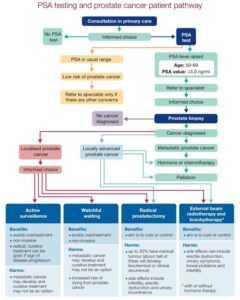Prostate Cancer Screening, Diagnosis, and Treatment
Prostate cancer is a significant health concern for men, with it being the second leading cause of cancer deaths in American men3. Screening for prostate cancer can help detect the disease at its earliest stages, allowing for successful treatment and optimal outcomes. However, the effectiveness of prostate cancer screening remains controversial, with organizations such as the American Academy of Family Physicians and the U.S. Preventive Services Task Force recommending against routine screening due to the lack of evidence for its benefits and the potential side effects of treatment.
Screening for prostate cancer typically involves a digital rectal exam (DRE) and a prostate-specific antigen (PSA) test. The DRE involves a healthcare provider inserting a gloved, lubricated finger into the rectum to examine the prostate gland for any abnormalities, while the PSA test measures the level of PSA in the blood, which can be elevated in the presence of prostate cancer or other conditions such as an enlarged prostate or inflammation. However, the PSA test can also result in false-positive or false-negative results, leading to unnecessary biopsies or missed diagnoses.
If an abnormality is detected through screening, further tests such as a transrectal ultrasound or biopsy may be conducted to confirm the diagnosis and determine the stage of the cancer. The stage of prostate cancer is indicated by Roman numerals ranging from I to IV, with lower stages indicating that the cancer is confined to the prostate and higher stages indicating that it has grown beyond the prostate and may have spread to other areas of the body.
Treatment options for prostate cancer include curative treatments for cancers confined to the prostate, such as radical prostatectomy or radiotherapy, and palliative treatments for more advanced stages of the disease. The choice of treatment depends on various factors, including the stage and grade of the cancer, the patient’s age and overall health, and their personal preferences.
In conclusion, while prostate cancer screening can help detect the disease at its earliest stages, the benefits of routine screening remain unproven, and the potential side effects of treatment must be carefully considered. Men should discuss the pros and cons of prostate cancer screening with their healthcare provider, taking into account their risk factors and personal preferences. If prostate cancer is detected, further tests will be needed to confirm the diagnosis and determine the stage of the cancer, which will inform the choice of treatment.
What is the recommended age for prostate cancer screening
Prostate cancer screening guidelines recommend that men discuss the potential benefits and harms of PSA screening with their healthcare provider and make an individualized decision about whether to get screened. The U.S. Preventive Services Task Force (USPSTF) recommends that men ages 55 to 69 years discuss the possible benefits and harms of PSA screening with their health care provider and make an individualized decision about whether to get screened. The American Cancer Society recommends that men have a chance to make an informed decision with their health care provider about whether to be screened for prostate cancer, and the decision should be made after getting information about the possible benefits, risks, and uncertainties of prostate cancer screening.

The recommended age for prostate cancer screening varies depending on the individual’s risk factors and overall health. For men at average risk of prostate cancer, the American Cancer Society recommends that screening discussions begin at age 50, while for men at high risk (such as those with a family history of prostate cancer or who are African American), screening discussions should begin at age 45.
The USPSTF recommends that men aged 55-69 years discuss the potential benefits and harms of PSA screening with their healthcare provider and make an individualized decision about whether to get screened. For men aged 70 years and older, the USPSTF recommends against PSA-based screening for prostate cancer.It is important to note that prostate cancer screening can lead to both benefits and harms. PSA screening can detect prostate cancer at an earlier stage, which may allow for more effective treatment and improved outcomes. However, PSA screening can also lead to false-positive results, overdiagnosis, and overtreatment, which can result in unnecessary procedures, complications, and anxiety. Therefore, it is essential that men have a thorough discussion with their healthcare provider about the potential benefits and harms of PSA screening before making a decision.
In summary, the recommended age for prostate cancer screening varies depending on individual risk factors and overall health. Men at average risk of prostate cancer should begin having discussions about PSA screening with their healthcare provider at age 50, while those at high risk should begin discussions at age 45. Men aged 55-69 years should discuss the potential benefits and harms of PSA screening with their healthcare provider and make an individualized decision about whether to get screened. Men aged 70 years and older should not be screened for prostate cancer routinely. It is important that men have a thorough discussion with their healthcare provider about the potential benefits and harms of PSA screening before making a decision.
What are the early symptoms of Prostate Cancer
The early symptoms of prostate cancer can be subtle and may not always be present. However, some potential early signs of prostate cancer include:
- A painful or burning sensation during urination or ejaculation.
- Frequent urination, especially at night.
- Difficulty stopping or starting urination.
- Sudden erectile dysfunction.
- Blood in urine or semen.
- Unusually weak urine flow.
- Unexplained pain around the prostate.
It is important to note that these symptoms can also be caused by other, less serious conditions such as benign prostatic hyperplasia (BPH), kidney stones, prostatitis, or urinary tract infections (UTIs). If you experience any of these symptoms, it is crucial to consult with a healthcare provider for proper evaluation and diagnosis.





